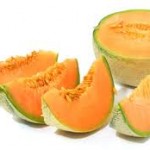 A research study conducted by the U.S. Department of Agriculture’s Agricultural Research Service has found that high-intensity ultraviolet-C (UVC) lights are effective in improving the quality and shelf life of fresh-cut cantaloupe melon. The findings of the study, which used high-output UVC lights manufactured by Steril-Aire, Inc., have far-reaching implications because the $15 billion fresh-cut produce industry is one of the fastest growing categories in the U.S. food market today.
A research study conducted by the U.S. Department of Agriculture’s Agricultural Research Service has found that high-intensity ultraviolet-C (UVC) lights are effective in improving the quality and shelf life of fresh-cut cantaloupe melon. The findings of the study, which used high-output UVC lights manufactured by Steril-Aire, Inc., have far-reaching implications because the $15 billion fresh-cut produce industry is one of the fastest growing categories in the U.S. food market today.
Olusola Lamikanra, a chemist with ARS’s Food Processing and Sensory Quality Research Unit and leader of the study, says: “What is holding fresh-cut fruits back are the physiological and biochemical changes that occur when they are processed and stored. Compared to vegetables, fruits commonly used for the fresh-cut market generally have a higher pH and water content, making them more vulnerable to microorganisms and enzymatic changes.” When fruit is sliced, he noted, sensory qualities such as taste and texture will be altered, nutrients lost, and bacteria and molds introduced.
In the study, researchers investigated the potential for high-output UVC light to diminish these vulnerabilities. They compared three groups of cut cantaloupe: (1) melon exposed to UVC light after processing – the most common method of UVC application; (2) melon exposed to UVC during the cutting process; and (3) a control group of non-UVC-treated cut fruit.
The UVC light source was a 24″-long, food-grade Steril-Aire “UVC Emitter™”. The research team cut the melons uniformly and exposed them to UVC irradiation for approximately four minutes. The cut fruit from all three test groups then underwent a series of tests to measure enzymatic activity, respiration rate, texture and microbiological activity. In addition, nine experienced panelists performed a descriptive sensory analysis of cut melon samples.
According to the study, “Results indicate that while post-cut application of UV improved shelf life of cut cantaloupe melon, cutting fruit under UVC radiation further improves product quality.”
More specifically, the study found that UVC radiation during processing reduced rancidity and improved firmness retention in the stored fruit. It also reduced spoilage microorganisms such as mesophilic and lactic acid bacteria.
UVC energy is best known in the food industry for its ability to kill or inactivate mold and bacteria that may contaminate food products. The cantaloupe study supports this premise – yet it provides important new evidence that UVC also produces favorable enzymatic changes during processing. “Cutting a cantaloupe under UVC light causes a hypersensitive defense response to take place within its tissues,” states Lamikanra. He says the reaction can be compared to the way we create antibodies when confronted with environmental stresses. This UVC-induced stress response helps explain how the fruit stayed fresher for several days longer.
Lamikanra plans to conduct a second phase of the study to investigate how one or more exposures to UVC light may be combined with other technologies to further enhance produce shelf life and quality. By extending the shelf life of high-value perishable food items, food processors can achieve greater profitability and operational efficiencies.




















